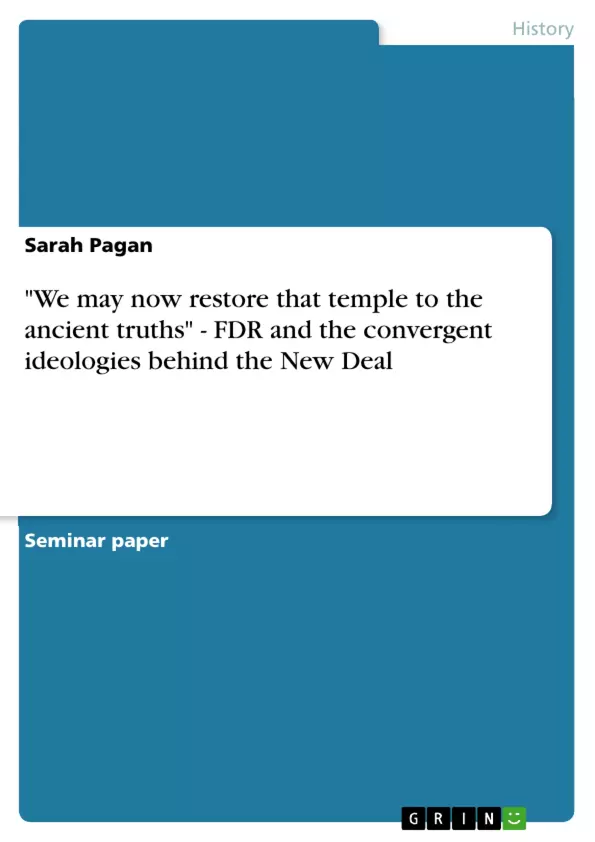My paper will trace the era of the 32. President of the United States of America, Franklin
Delano Roosevelt (FDR)1, Member of the Democrats, who introduced the president as an
active and representative member of the government. His presidency (1933-1945) had a
duration of three terms, and part of a fourth term. He emerged as the Great Depression and
the banking crisis had reached their peak. America was in need of governmental
intervention. Whilst the Hooverian times can be cited as having stood under a rather
diffident administration, the FDR era signifies a shift towards activeness of the executive
branch in terms of decision making and the initiating of laws. Roosevelts' presidency is in
so far one of the most significant in the history of the American presidency, as this
administration would overcome certain historical concepts, that had often before proven to
be problematic. There were issues such as the strict separation of powers and the Congress'
domination over the White House which were seen upon differently 1947, when Truman
took over the presidency from FDR, than in 1932, before Roosevelt was elected.
This transformation through Roosevelt's administration has its foundation in many
aspects. It overcame problematic historical concepts such as the strict separation of powers
and the Congress' domination over the White House and changed it for good. Also FDR
gave a new meaning to agenda setting and managed to define a new president-to-citizenrelationship,
making use of news media and radio to directly communicate to the people
whilst before him the president and his personality played a minor role in this office.
But the most important action Roosevelt took was initiating the „New Deal“,a
concept which contains so many levels, that they can hardly be outlaid in total in this term
paper. It is a complex and disputed topic that is in some points even held vaguely, countless
books have been written about this era and viewed it from historical, legal, institutional,
even psychological aspects.
Inhaltsverzeichnis (Table of Contents)
- I. Introduction
- II. Governmental takeover
- II. 1. Hoover: the diffident predecessor
- II. 2. Elections 1932
- III. New Deal: the reforms
- IV. Intellectual Governing and a collective dynamism
- IV. 1.Franklin D. Roosevelt - a political theorist?
- IV. 2.,,Brain Trust\", the discordant group behind FDR
- V. Conclusion
- VI. Attachements:
- Figures
- List of figures
- References
Zielsetzung und Themenschwerpunkte (Objectives and Key Themes)
This paper aims to examine the era of President Franklin Delano Roosevelt (FDR) and his significant role in reshaping the American presidency. It explores the context of the Great Depression and how FDR's "New Deal" reforms addressed the crisis and redefined the relationship between the president and the people. The paper focuses on the ideological foundations behind the New Deal, analyzing the motivations, philosophies, and key actors involved in its implementation.- The evolution of the American presidency under FDR, particularly the shift towards a more active executive branch.
- The ideological underpinnings of the New Deal and its impact on American political thought.
- The role of FDR's "Brain Trust" and the dynamics of collective decision-making in the administration.
- The use of media and communication strategies to shape public opinion and the president-to-citizen relationship.
- The contrasting political approaches of FDR and his predecessor, Herbert Hoover, and their respective responses to the Great Depression.
Zusammenfassung der Kapitel (Chapter Summaries)
I. Introduction
This chapter introduces the topic of the paper, which explores the influence of President Franklin Delano Roosevelt (FDR) on the American presidency during the Great Depression. The paper focuses on understanding the ideological basis for FDR's "New Deal" reforms, analyzing the motivations behind their implementation and the diverse perspectives within FDR's administration.II. Governmental takeover
This section delves into the political climate leading up to FDR's presidency, highlighting the contrasting approaches of his predecessor, Herbert Hoover, and the challenges posed by the Great Depression. The chapter explores Hoover's reliance on a more traditional, hands-off approach to governance, contrasting it with FDR's campaign and his vision for a more active and responsive government.III. New Deal: the reforms
This chapter introduces the concept of the New Deal and its complexity. While the chapter does not delve into a detailed chronological analysis of the New Deal's reforms, it highlights the multifaceted nature of the program and emphasizes the need to understand its ideological underpinnings.IV. Intellectual Governing and a collective dynamism
This section examines the role of intellectual discourse and the dynamics within FDR's administration, focusing on the "Brain Trust," a group of advisors tasked with assisting the president in making crucial decisions. The chapter explores the internal conflicts and divergent perspectives within the group, highlighting the challenges of collective decision-making in the context of a dynamic political landscape.Schlüsselwörter (Keywords)
The key concepts explored in this paper include:- American presidency
- FDR
- New Deal
- Great Depression
- Brain Trust
- Ideology
- Governmental intervention
- Political theory
- Public administration
- Laissez-faire
- Quote paper
- Sarah Pagan (Author), 2011, "We may now restore that temple to the ancient truths" - FDR and the convergent ideologies behind the New Deal, Munich, GRIN Verlag, https://www.grin.com/document/209146



